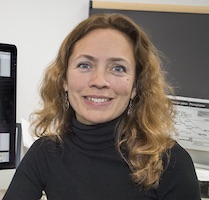
Dear Foundry Community,
It was delightful to see so many of you at this year’s Annual User Meeting (AUM). I’d like to thank the Molecular Foundry’s User Executive Committee (UEC), and in particular its chair, Boyce Chang, as well as the rest of the organizing committee and the User Program Office team for bringing everyone together onsite and for putting together such an engaging agenda. I’m sure we will see new collaborations growing as a result.
The AUM showcased, through keynote presentations, interactive workshops, and collaborative sessions, the importance of nanoscale science research in addressing complex global challenges. We were excited to welcome former Foundry Director and recent Nobel Laureate Carolyn Bertozzi back as one of our keynote speakers, where she spoke on the advancement of bioorthogonal chemistry and received a ceremonial sign in honor of the new Bertozzi Road at Berkeley Lab. The meeting was also an opportunity for us to showcase new capabilities that will be available to our users in the upcoming proposal call. New Foundry staff scientist Aeron Tynes Hammack, who joined the Nanofabrication Facility in the spring, is developing comprehensive single particle sensing nanofluidic integrated circuits, toward the understanding of self-assembly processes that underpin single and multicellular life. Sinéad Griffin of the Theory of Nanostructured Materials Facility is developing methodologies with ab initio accuracy to describe and predict quantum phenomena in disordered and amorphous materials, with applications including superconductors, topological materials and magnetic materials. Ed Barnard’s Data Infrastructure team is building new automated equipment, implementing data sharing and analysis pipelines, and building data support infrastructure to encompass the entire life cycle of scientific data. Another new capability available for users via our Theory Facility this call is Liang Tan’s INQ code for nonperturbative real-time dynamics, an engine for real-time electronic structure simulations, using time-dependent density functional theory to simulate electronic and ionic motion far from equilibrium. I hope many of you will begin to take advantage of these new capabilities in our next proposal call, which opens tomorrow with a deadline of Thursday, September 28.
While the Foundry welcomes users from all over the world to learn to make use of our tools and expertise, we also reach out to the next generation of scientists through internship programs at Berkeley Lab like ASPIRES (Advancing Stem Pioneers In Research In Energy Sciences), Experiences in Research, and the Foundry’s own FUSE internship. We had staff participate as mentors in all of these programs this summer and it was exciting to see the culmination of the students’ efforts at the poster sessions at the beginning of this month.
We have also recently welcomed a few other new staff to the Foundry as we continue to fill the spaces from the last years’ staffing changes. Meredith Goudreau has worked with the Foundry since 2022 as a Student Assistant and has recently transitioned into a technical staff role in the Imaging and Nanofabrication facilities. Rachel Alvelais has joined the Inorganic facility this month supporting users and staff working with solution phase nanostructures, following her recent PhD from UC Irvine in the synthesis and characterization of small molecule inorganic complexes. Finally, Morgan Wall also joined us this month as a part of the Foundry’s new Data Infrastructure group with a background in bioinformatics and data engineering. I’m excited for everyone to meet our newest staff members and welcome them to the team!
In closing, I encourage you to take the opportunity of our upcoming proposal call to build off of what you heard at the AUM, as well as our new expertise and capabilities, to develop new and exciting ways to collaborate with the Foundry. I look forward to seeing these ideas and working with you in the future.
All the Best,
Kristin

